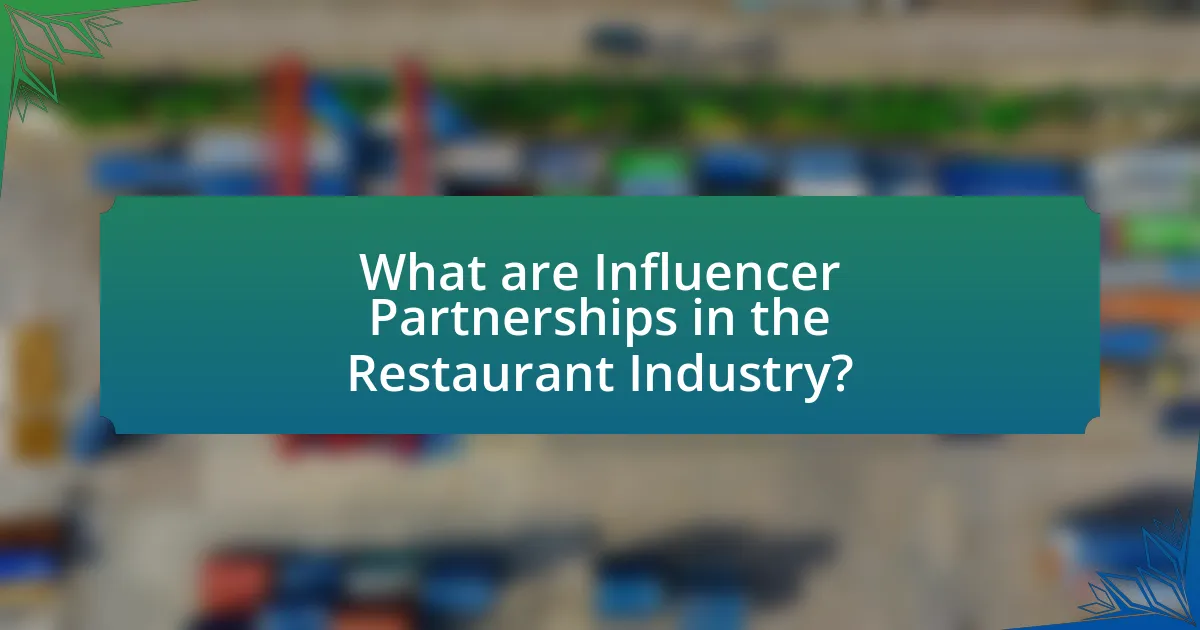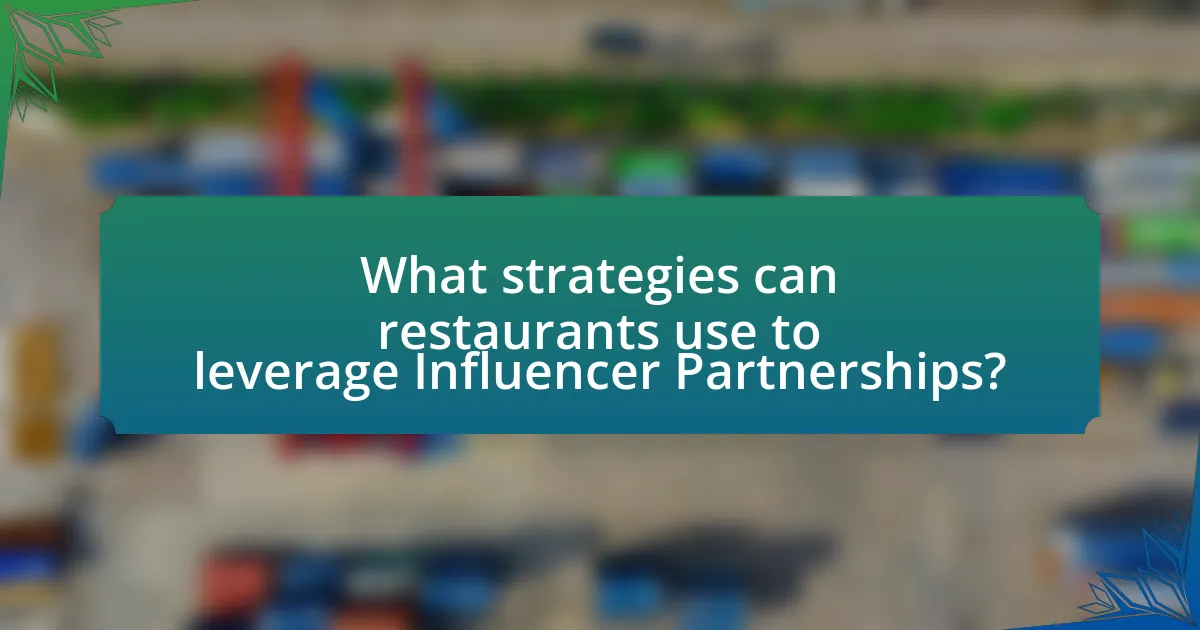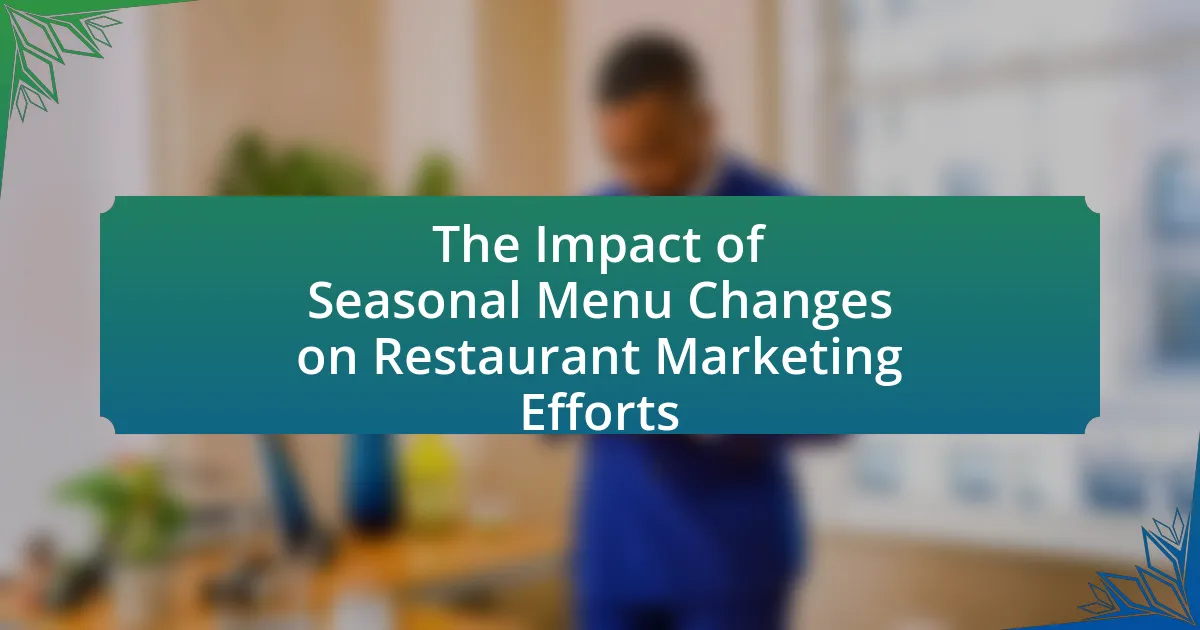Influencer partnerships in the restaurant industry involve collaborations between restaurants and social media influencers to enhance brand visibility and attract new customers. These partnerships leverage the influencer’s audience and credibility, with micro-influencers proving particularly effective due to their high engagement rates and authentic connections with followers. The article explores how these partnerships work, the types of influencers that are most beneficial, strategies for identifying the right influencers, and the potential challenges and risks involved. Additionally, it discusses best practices for engaging with influencers and measuring the success of these collaborations, emphasizing the importance of authenticity and alignment in building long-term relationships.

What are Influencer Partnerships in the Restaurant Industry?
Influencer partnerships in the restaurant industry are collaborations between restaurants and social media influencers to promote the restaurant’s brand, menu, or events. These partnerships leverage the influencer’s reach and credibility to attract new customers and enhance brand visibility. For instance, a study by the Digital Marketing Institute found that 49% of consumers depend on influencer recommendations when making purchasing decisions, highlighting the effectiveness of such collaborations in driving customer engagement and increasing foot traffic to restaurants.
How do Influencer Partnerships work for restaurants?
Influencer partnerships for restaurants involve collaborating with social media influencers to promote the restaurant’s brand, menu, and overall dining experience. Restaurants typically provide influencers with complimentary meals or exclusive experiences in exchange for content creation, such as posts, stories, or videos showcasing the restaurant. This strategy leverages the influencer’s audience to reach potential customers, as studies show that 49% of consumers depend on influencer recommendations when making purchasing decisions. By targeting influencers whose followers align with the restaurant’s target demographic, restaurants can effectively enhance their visibility and attract new patrons.
What types of influencers are most effective for restaurant promotions?
Micro-influencers are the most effective type of influencers for restaurant promotions. They typically have a smaller but highly engaged following, often ranging from 1,000 to 100,000 followers, which allows for more authentic interactions and recommendations. Research indicates that micro-influencers can achieve engagement rates of up to 7%, significantly higher than the 1-3% engagement rates of larger influencers. This higher engagement translates to more effective promotion, as their followers often trust their opinions more due to perceived authenticity. Additionally, micro-influencers tend to have niche audiences, which can align closely with specific restaurant themes or cuisines, enhancing targeted marketing efforts.
How do influencers engage with their audience to promote restaurants?
Influencers engage with their audience to promote restaurants primarily through authentic content creation and interactive communication. They share visually appealing images and videos of their dining experiences, often highlighting unique dishes and restaurant ambiance, which resonates with their followers. For instance, a study by the Digital Marketing Institute found that 49% of consumers depend on influencer recommendations for their purchasing decisions, indicating the effectiveness of this engagement strategy. Additionally, influencers often host giveaways or exclusive events, encouraging audience participation and fostering a sense of community around the restaurant brand. This interactive approach not only boosts visibility but also builds trust and loyalty among potential customers.
Why are Influencer Partnerships important for restaurant visibility?
Influencer partnerships are important for restaurant visibility because they leverage the influencer’s established audience to reach potential customers effectively. Influencers have the ability to create authentic content that resonates with their followers, which can lead to increased brand awareness and customer engagement for restaurants. According to a study by the Digital Marketing Institute, 49% of consumers depend on influencer recommendations when making purchasing decisions, highlighting the significant impact influencers have on consumer behavior. This partnership not only enhances visibility but also builds credibility and trust, as followers often view influencers as relatable and trustworthy sources.
What impact do influencer partnerships have on customer reach?
Influencer partnerships significantly enhance customer reach for restaurants. By leveraging the established trust and audience of influencers, restaurants can access a broader demographic that may not have been aware of their offerings. For instance, a study by the Digital Marketing Institute found that 49% of consumers depend on influencer recommendations when making purchase decisions, indicating that influencer partnerships can effectively drive awareness and engagement. Additionally, influencer content often generates higher engagement rates, with posts receiving up to 10 times more interactions than traditional advertising, further amplifying the restaurant’s visibility among potential customers.
How do influencer partnerships enhance brand credibility for restaurants?
Influencer partnerships enhance brand credibility for restaurants by leveraging the trust and authority that influencers have established with their followers. When a reputable influencer endorses a restaurant, their audience perceives the recommendation as a personal endorsement, which significantly boosts the restaurant’s credibility. According to a study by the Digital Marketing Institute, 49% of consumers depend on influencer recommendations for their purchasing decisions, indicating that influencer endorsements can effectively sway public perception and increase trust in a brand. This trust translates into higher customer engagement and can lead to increased foot traffic and sales for the restaurant.

What strategies can restaurants use to leverage Influencer Partnerships?
Restaurants can leverage influencer partnerships by collaborating with food bloggers and social media personalities to enhance their visibility and attract new customers. By selecting influencers whose audience aligns with their target demographic, restaurants can create authentic content that showcases their menu items and dining experience. For instance, a study by the Digital Marketing Institute found that 49% of consumers depend on influencer recommendations when making purchasing decisions, highlighting the effectiveness of this strategy. Additionally, offering exclusive promotions or hosting influencer events can further engage their followers and drive traffic to the restaurant.
How can restaurants identify the right influencers for their brand?
Restaurants can identify the right influencers for their brand by analyzing the influencer’s audience demographics, engagement rates, and content relevance. By using tools like social media analytics and influencer marketing platforms, restaurants can assess whether an influencer’s followers align with their target customer base. For instance, a restaurant targeting health-conscious diners should seek influencers who focus on healthy eating and have a following that reflects this interest. Additionally, engagement metrics such as likes, comments, and shares provide insight into how effectively an influencer connects with their audience, which is crucial for driving restaurant visibility.
What criteria should restaurants consider when selecting influencers?
Restaurants should consider the influencer’s audience demographics when selecting influencers. This ensures that the influencer’s followers align with the restaurant’s target market, maximizing engagement and potential customer conversion. For instance, if a restaurant specializes in vegan cuisine, partnering with an influencer who has a significant following of health-conscious individuals or vegans will likely yield better results. Additionally, the influencer’s engagement rate is crucial; a high engagement rate indicates that their audience is actively interacting with their content, which can lead to increased visibility for the restaurant. Furthermore, the influencer’s content style and values should resonate with the restaurant’s brand identity, ensuring authenticity in the partnership. Lastly, previous collaborations and the influencer’s reputation in the food industry can provide insights into their effectiveness and reliability, making them a more strategic choice for partnership.
How can restaurants evaluate an influencer’s audience engagement?
Restaurants can evaluate an influencer’s audience engagement by analyzing metrics such as likes, comments, shares, and overall interaction rates on the influencer’s posts. These metrics provide insight into how actively the audience engages with the content, indicating the influencer’s effectiveness in reaching and resonating with their followers. For instance, a study by Influencer Marketing Hub found that posts with higher engagement rates (above 3%) typically lead to better brand awareness and customer conversion, validating the importance of these metrics in assessing influencer partnerships.
What types of content can influencers create for restaurants?
Influencers can create various types of content for restaurants, including food photography, video reviews, live cooking demonstrations, and social media posts showcasing the dining experience. Food photography captures visually appealing images of dishes, which can attract potential customers by highlighting the restaurant’s offerings. Video reviews provide an engaging format for influencers to share their thoughts on the food, ambiance, and service, often leading to increased interest and foot traffic. Live cooking demonstrations allow influencers to showcase the restaurant’s culinary skills in real-time, creating a connection with the audience. Social media posts can include stories, reels, and posts that promote special events or menu items, effectively reaching a wider audience and enhancing the restaurant’s visibility.
How can visual content enhance a restaurant’s appeal through influencers?
Visual content can enhance a restaurant’s appeal through influencers by showcasing the restaurant’s ambiance, dishes, and unique experiences in an engaging manner. Influencers, who often have large and dedicated followings, can create high-quality images and videos that highlight the restaurant’s offerings, making them more attractive to potential customers. For instance, a study by the Digital Marketing Institute found that posts with visuals receive 94% more views than those without, indicating that visual content significantly increases engagement. This enhanced visibility can lead to increased foot traffic and higher sales, as potential diners are more likely to visit a restaurant that they perceive as visually appealing and trendy.
What role do reviews and testimonials play in influencer marketing for restaurants?
Reviews and testimonials are crucial in influencer marketing for restaurants as they enhance credibility and trust among potential customers. Influencers often share their personal experiences and opinions about a restaurant, which can significantly influence their followers’ dining decisions. According to a survey by BrightLocal, 79% of consumers trust online reviews as much as personal recommendations, highlighting the impact of testimonials in shaping consumer behavior. Additionally, positive reviews can amplify the reach of influencer content, leading to increased visibility and foot traffic for restaurants.

What are the potential challenges of Influencer Partnerships for restaurants?
Influencer partnerships for restaurants can face several potential challenges, including misalignment of brand values, inconsistent messaging, and varying audience engagement levels. Misalignment occurs when the influencer’s image or values do not resonate with the restaurant’s target demographic, potentially leading to negative perceptions. Inconsistent messaging can arise if influencers do not accurately represent the restaurant’s offerings or brand voice, which may confuse potential customers. Additionally, varying audience engagement levels can result in some influencers delivering low return on investment, as their followers may not be genuinely interested in dining experiences. According to a study by Influencer Marketing Hub, 61% of marketers cite finding the right influencers as their biggest challenge, highlighting the importance of careful selection in partnerships.
What risks should restaurants be aware of when partnering with influencers?
Restaurants should be aware of several risks when partnering with influencers, including reputational damage, misalignment of brand values, and potential legal issues. Reputational damage can occur if an influencer engages in controversial behavior or makes inappropriate comments, which can reflect poorly on the restaurant. Misalignment of brand values happens when the influencer’s image or messaging does not resonate with the restaurant’s target audience, leading to ineffective marketing. Additionally, legal issues may arise from non-disclosure agreements or failure to comply with advertising regulations, which can result in fines or legal action. According to a 2021 survey by the Digital Marketing Institute, 61% of marketers reported that influencer partnerships can backfire if not carefully managed, highlighting the importance of thorough vetting and clear communication in these collaborations.
How can negative influencer behavior affect a restaurant’s reputation?
Negative influencer behavior can significantly harm a restaurant’s reputation by spreading unfavorable perceptions among potential customers. When an influencer engages in negative actions, such as making inappropriate comments or sharing poor experiences, their large following may interpret these actions as a reflection of the restaurant’s values and quality. For instance, a study by the Pew Research Center found that 70% of social media users trust influencers’ opinions, meaning that negative remarks can lead to a swift decline in customer interest and trust. This decline can manifest in decreased foot traffic, negative online reviews, and a tarnished brand image, ultimately affecting the restaurant’s profitability and long-term success.
What steps can restaurants take to mitigate risks associated with influencer partnerships?
Restaurants can mitigate risks associated with influencer partnerships by conducting thorough research on potential influencers, establishing clear contracts, and monitoring content. Researching influencers involves assessing their audience demographics, engagement rates, and past collaborations to ensure alignment with the restaurant’s brand values. Establishing clear contracts outlines expectations, deliverables, and compensation, which helps prevent misunderstandings. Monitoring content ensures that the influencer’s posts accurately represent the restaurant and adhere to agreed-upon guidelines, reducing the risk of negative publicity. These steps are essential for maintaining brand integrity and fostering successful partnerships.
How can restaurants measure the success of their influencer partnerships?
Restaurants can measure the success of their influencer partnerships through key performance indicators (KPIs) such as engagement rates, reach, and conversion metrics. Engagement rates, which include likes, comments, and shares on influencer posts, provide insight into how well the content resonates with the audience. Reach indicates the number of unique users who see the content, helping restaurants understand the potential audience exposure. Conversion metrics, such as the number of reservations or increased foot traffic attributed to the influencer’s promotion, directly reflect the partnership’s impact on sales. For instance, a study by Influencer Marketing Hub found that businesses earn an average of $5.78 for every dollar spent on influencer marketing, highlighting the financial effectiveness of successful partnerships.
What metrics should restaurants track to assess influencer impact?
Restaurants should track engagement rate, reach, impressions, referral traffic, and conversion rate to assess influencer impact. Engagement rate measures how actively followers interact with the influencer’s content related to the restaurant, indicating audience interest. Reach and impressions quantify how many people saw the content, providing insight into the influencer’s visibility. Referral traffic tracks the number of visitors directed to the restaurant’s website or social media from the influencer’s posts, showing direct interest. Conversion rate measures the percentage of those visitors who make a reservation or purchase, reflecting the effectiveness of the influencer’s promotion. These metrics collectively provide a comprehensive view of the influencer’s impact on restaurant visibility and customer engagement.
How can customer feedback inform the effectiveness of influencer campaigns?
Customer feedback can inform the effectiveness of influencer campaigns by providing insights into audience perceptions and engagement levels. Analyzing customer reviews and comments related to influencer promotions reveals how well the campaign resonates with the target demographic. For instance, a study by Nielsen found that 92% of consumers trust recommendations from individuals over brands, indicating that positive feedback can enhance credibility and drive sales. Additionally, tracking metrics such as engagement rates and sentiment analysis of customer feedback can help marketers adjust strategies in real-time, ensuring that influencer partnerships align with consumer expectations and preferences.
What best practices should restaurants follow when engaging with influencers?
Restaurants should prioritize authenticity and alignment with influencers who share similar values and target audiences. Engaging influencers whose content resonates with the restaurant’s brand enhances credibility and fosters genuine connections with potential customers. For instance, a study by the Digital Marketing Institute found that 49% of consumers depend on influencer recommendations, highlighting the importance of selecting influencers who can authentically represent the restaurant’s offerings. Additionally, establishing clear expectations regarding deliverables, timelines, and compensation ensures a mutually beneficial partnership. This structured approach not only clarifies roles but also enhances the likelihood of successful campaigns that drive visibility and engagement.
How can restaurants build long-term relationships with influencers?
Restaurants can build long-term relationships with influencers by engaging in consistent and authentic collaboration. Establishing clear communication and mutual benefits is essential; for instance, restaurants can offer exclusive experiences or menu tastings to influencers, fostering a sense of partnership. Additionally, maintaining ongoing interactions through social media and personalized outreach helps to strengthen these relationships. Research indicates that 70% of consumers are more likely to trust a brand when they see it endorsed by influencers they follow, highlighting the effectiveness of sustained influencer engagement in enhancing restaurant visibility.
What are the key elements of a successful influencer partnership agreement?
The key elements of a successful influencer partnership agreement include clear objectives, defined deliverables, compensation structure, timelines, and legal considerations. Clear objectives ensure both parties understand the goals of the partnership, such as increasing brand awareness or driving traffic to a restaurant. Defined deliverables specify the content type, frequency, and platforms for posting, which helps manage expectations. A compensation structure outlines payment terms, whether monetary or in-kind, ensuring fairness and transparency. Timelines establish when content will be created and published, facilitating coordination. Legal considerations, including usage rights and disclosure requirements, protect both parties and comply with regulations. These elements collectively contribute to a well-structured agreement that enhances the effectiveness of influencer partnerships in boosting restaurant visibility.




